Buy Carnivorous Plants Online!
Buy carnivorous plants from the most reputable and trusted carnivorous plant nursery, California Carnivores. We have partnered up and are giving all my viewers an exclusive 10% discount on your entire carnivorous plant order! Just enter CPHUB at checkout! Get the coolest venus flytrap cultivars, sarracenia, nepenthes and much MUCH more! You can even buy your next bag of premium carnivorous plant soil from them! Order Plant Mail, Click Here! Thank you so much for stopping by to check out some interesting venus flytrap facts. Whether your here because your interested in growing your own venus flytrap or your a teacher here looking for venus flytrap facts for kids or maybe you need to write some kind of report on venus flytraps, I think your going to find something you like.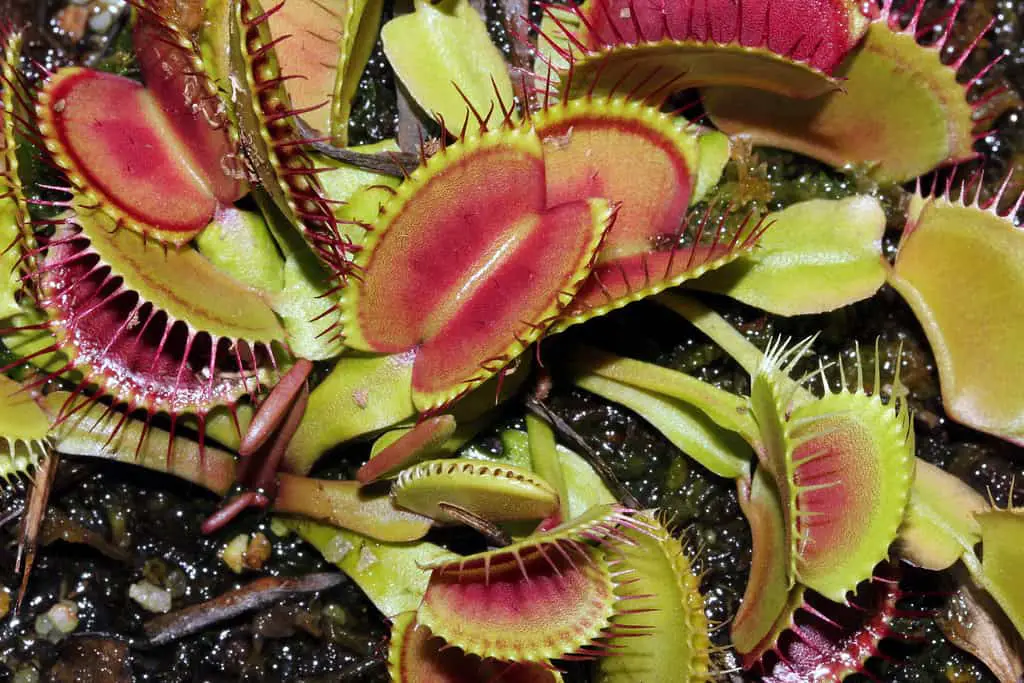
| We are a participant in the Amazon Services LLC Associates Program, an affiliate advertising program designed to provide a means for sites to earn advertising fees by advertising and linking to Amazon.com. |
Cool venus flytrap with super red traps, love it!
Ultimate Venus Fly Trap Care Guide
Venus Flytrap Facts
Before we get into the more interesting facts about venus flytraps, lets go over some of the basics. Even though it’s not as exciting the basic information is important to understand.- Scientific Name – Dionaea muscipula
- Rank – Species
- Diet – Carnivore
- Average Life Span In Wild – 25 Years
- Size – Plant – 4-12 inches – Trap – Up To 2 Inches Long
Interesting Facts About Venus Flytraps
I hope your ready to be completely taken back by these amazing plants. I honestly couldn’t believe some of the information I read when researching these aggressive little carnivores. I think you will enjoy what you read below!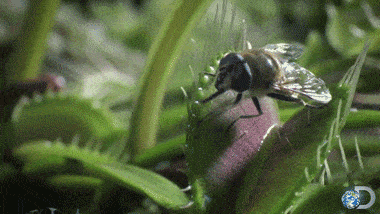
- Venus flytraps are considered carnivores, they eat flies and other crawling bugs to give them energy.
- To catch their prey, the venus flytrap has 3 little trigger hairs on each side of the trap. The insect must trigger these hairs 2 times in a 20 second period or the trap won’t close.
- The need to trigger the hairs twice is a fail safe for the venus flytrap. They want to make sure if they use the energy to trigger the trap that it’s a real insect. This prevents raindrops and falling leaves from triggering the plant as much.
- If one hair is triggered and the 20 second clock runs out, they reset and wait for another prey to trigger the trap.
- Venus flytraps eat insects due to their incredibly acidic soil. This soil lacks nutrients so the must find their nutrition and energy elsewhere.
- Venus flytraps grow in the unlikeliest of places, a bog. Bogs are devoid of much nutrient rich soil and are constantly wet, making it a hard place for a plant to grow. This is why the venus flytrap evolved to eat insects instead of relying on it’s soil.
- Venus flytraps are very slow growers, if you grow one from a seed they will take 2-4 years to reach about 3-5 inches in height and be at full maturity. Click below to read an entire article I worked hard on all about how long it takes for a venus flytrap to grow! How Long Does It Take For A Venus Flytrap To Grow – Written by me, tirelessly!
- How Long Does It Take For A Venus Flytrap To Grow – Written by me, tirelessly!
- You can grow them from leaf cuttings however, this process will cut the grow time in half, 1-2 years.
- If you grow venus flytraps from seeds they will have a lot of genetic variance from plant to plant. The plant that grows from seeds harvested from another plant will be very different from a genetic standpoint.
- If you do leaf cutting and propagate the venus flytrap the plant that grows from the cut leave will be a genetic twin to the original plant.
- The venus flytrap grow to around 5 inches in diameter. Each plant has hinged leaves with usually about 6 stems.
- When a prey triggers the hairs on the venus flytrap, it snaps shut trapping the insect.
- The venus flytrap then releases enzymes that break down the insect so they can “eat” it.
- First the venus flytrap breaks down the insects exoskeleton then the plant uses the the nitrogen rich blood called hemolyph.
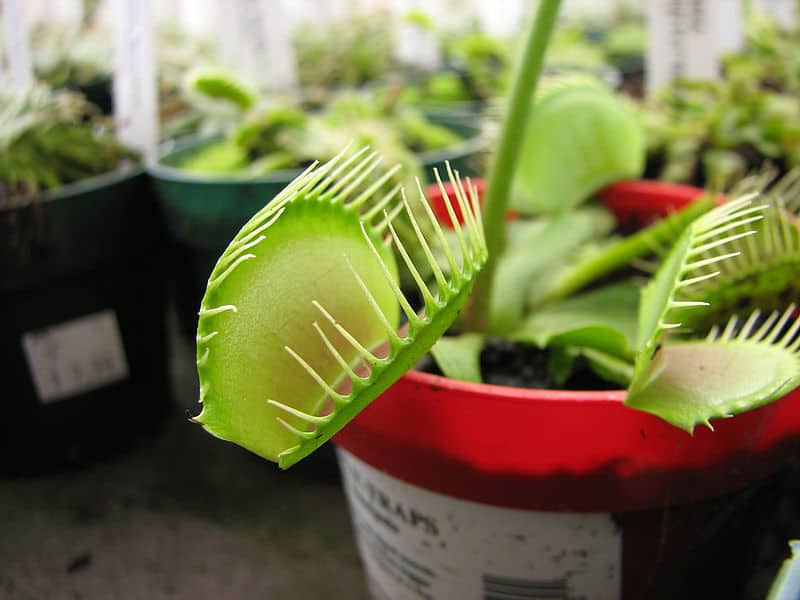
Venus flytraps being grown in planters.
- The venus flytrap grows all over the world but it originates from the bogs of North and South Carolina. Many people think that since it’s exotic it must grow in tropical locations, this is not the case.
- They need a lot of humidity and light to flourish.
- Flytraps secret a fragrant nectar that lures the prey into their trap.
- Once a flytrap has digested its prey it takes 5-12 days for the trap to reopen and prepare for its next meal.
- The venus flytrap doesn’t use the entire insect, there is a shell of the bug that falls out of the trap once its finished. The insect is usually ushered out with a light breeze.
- Althought they are called venus flytraps their primary food are not actually flies. The primary food is actually ants. They do eat flies but only about 5% of the time. Other insects they eat are slugs, beetles, spiders and even tiny frogs.
- Venus flytraps can be pollinated and reproduce like other plants. The seeds that the flower produce mature after 4-6 weeks and become black and pear-shaped. These seeds are then spread and grow into new plants.
- They can also reproduce asexually. The roots can create a bulb root and grow a brand new flytrap from the bulb. A gardener can then separate the roots and replant both to make 2 venus flytrap plants.
- The conservation status of venus flytraps is listed as vulnerable. This is due to habitat destruction and over harvesting. You can see more about their conservation status by going over to the red list website, click here!
- Our third president Thomas Jefferson gave growing venus flytraps a shot. He didn’t have a lot of luck but finally secured some seeds in 1804.
- Charles Darwin once wrote an entire book on carnivorous plants, the venus flytrap inspired him, he was a huge fan. “It’s the most wonderful plant in the world” he was quoted saying.
- Yes, robot Venus Flytraps are a thing. An article that was published in Popular Science, technicians in the US and South Korea have built robot replicas of the venus flytrap, how cool!
- Although Venus Flytraps are referred to as meat eaters, please don’t feed your flytrap any actual meat. Meat such as hamburger can cause the venus flytrap to rot, turn black and die.
- The circle of life is a real thing and the traps on the plant do not last forever. They will open and close an average of 6 times or so before permanently closes. It still helps by photosynthesizing but will no longer be able to contribute to the bigger plant by catching anymore insects.
- It is believed that the name of the venus flytrap originates from the pagan goddess of love, Venus. The name is meant to symbolize the way the plant lures in its prey.
Venus Flytrap Youtube Video
Okay, I know I just said we were going to do the Q&A but what would the article be without a cool video of Venus Flytraps? I’m not going to just share a bunch of Venus Flytrap Facts and not show you a video of them actually catching flies! So, lets get too it. Check out the awesome venus flytrap Youtube video below show the Venus Flytrap catching flies like an absolute BOSS! Okay, like I promised lets move on to the Venus Flytrap Q&A session.Venus Flytrap Fun Facts For Kids Q&A Session
I hope your ready to get your venus flytrap question answered. I scoured the internet for days tracking down the most common questions that people have about venus flytraps. I didn’t want to only share interesting facts about venus flytraps but I also wanted to hopefully answer some of your questions.How does a venus flytrap work?
This is a great question and I spent a lot of time actually writing an entire article on this very topic. Please click the link below to read more about how exactly a venus flytrap works. If your too lazy and just want to keep reading, I like your style, many questions about how a venus flytrap works will be answered below! Click here to read how a venus flytrap works!Where do you buy a venus flytrap.
This is definitely one of the most common questions I get. If you can, the best way to buy one is to look for a local nursery that grows venus flytraps. If you don’t have any locally you can actually even buy them on Amazon. I have linked below to a nursery that sells via Amazon and has good reviews and will sell healthy plants. The nice thing about buying from Amazon is it’s user friendly and if you have any issues and get bad plants, Amazon usually has your back! The link below will take you to a Medium Sized B52 Giant Venus Flytrap sold by Joels Carnivorous Plants. You can check the reviews and see what people are saying generally speaking he sells great healthy plants! Keep in mind that a lot of people buy venus flytraps without fully understanding their care. Just because someone bought one and it died doesn’t mean it was a bad plant, it’s more likely that they didn’t fully understand the care. See Reviews, Price and Buy Venus Flytraps Here!How much does a venus flytrap cost?
That is a great question and really aligns with the question above. You do have to be careful and watch out for people selling super cheap venus flytraps. You can expect to pay on average for a smaller plant $10. For a medium sized plant your looking at closer to $20. They obviously will range based on rareness and type of species but those are the prices you can expect. Click the link above to go on over to Joels Carnivorous Plants store on Amazon to price out the different plants he has!Is the venus flytrap a flower?
Why yes, yes it is. Not the way you might think however. The trap part of a venus flytrap is not a flower. The venus flytrap does produce a flower however. The flowers grow in small clusters and can grow as tall as 12 inches with it being mostly stem. The flower is white and is pretty but doesn’t have any real distinct features. Often times people will cut their flower off to help save energy for the trap heads. If you want to collect the seeds you will need to let the venus flytrap flower grow. There are other ways to grow new plants through propagation but some like to grow from the seed.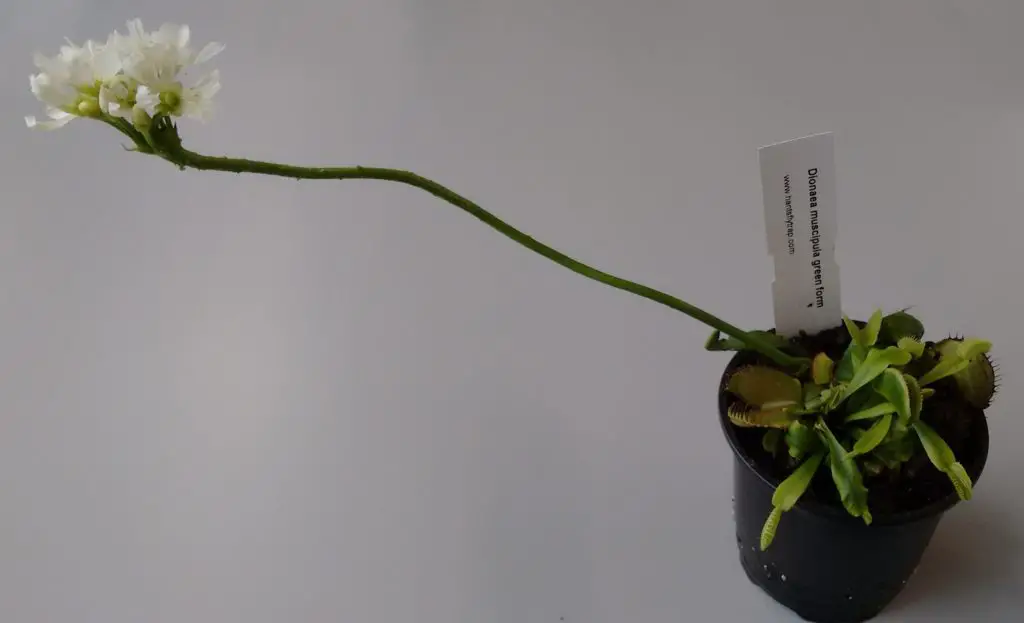
You can see how long these flowers get compared to the size of the plant.
Where does the venus flytrap grow?
This is one of the biggest misunderstandings with Venus Flytraps. Most people tend to think that these plants grow in jungles or in some exotic rain forest. The truth is, they just aren’t nearly that exciting. Are you ready for this? The venus flytrap grows naturally in North and South Carolina. And that’s it. Just those two states. They have since been successfully replanted and grow in other states and countries now, but they all come from North and South Carolina. Most specifically, they grow in bogs within North and South Carolina. The bogs are actually the reason they eat insects for nutrition. The soil there is so devoid of nitrogen and is so acidic the plants had to evolve and learn how to get their energy by different means. You can now find the through Florida and New Jersey. So no, they are not a tropical plan and actually will go into dormancy during the winter months. They can withstand the cold and will go into a state where they almost appear dead. They don’t die however they go through a similar stage as animals do with hibernation.What does a venus flytrap eat?
Well, duh… They are called a FLYtrap, so they eat flies, right? Well yes, but mostly no. Flies are probably one of the cooler preys they lure but its certainly not the only. Actually, in most locations flies only account for about 5% of the venus flytraps total diet. The majority of their diet consists of ants and other crawlers. They will consume spiders, slugs, beetles and have even been known to trap and eat a small frog. Although in most cases if the prey is too large the flytrap will open up and let it go due to the struggle. If the prey is too large the insect or animal can become covered in parasites and decay that can actually hurt the venus flytrap. The process of breaking down larger insects or small animals simply takes too long and can invite other nasty things that hurt the flytrap.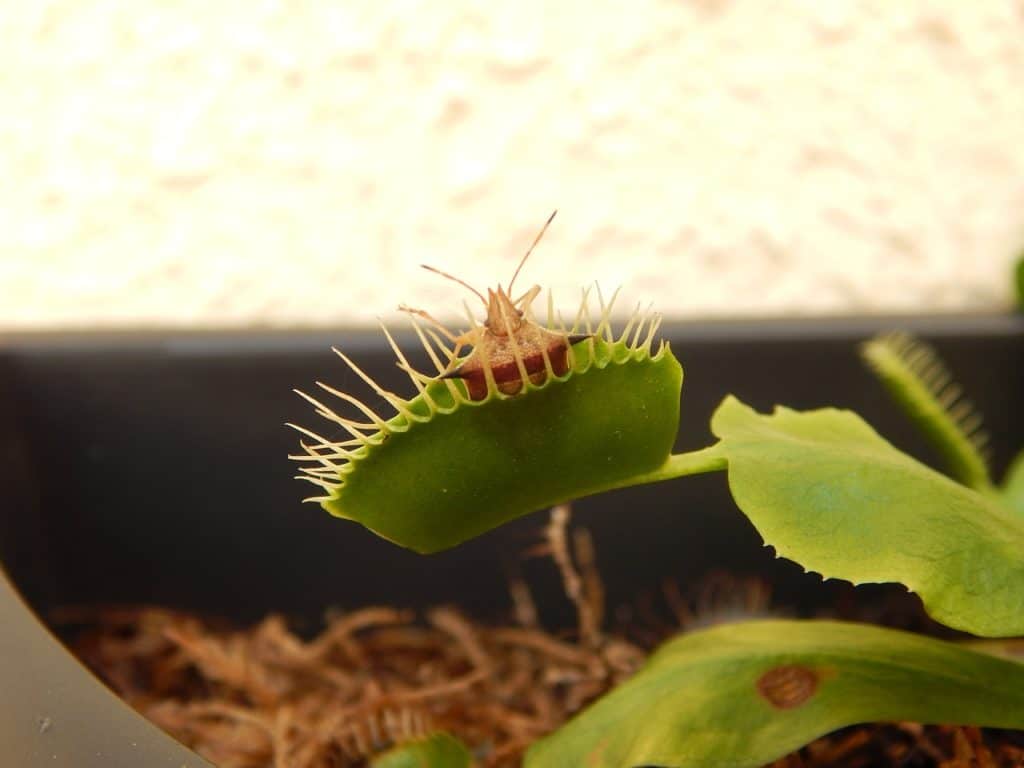
The venus flytrap is more likely to catch a spider or crawling critter than a fly.


